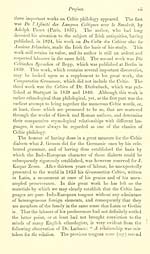Blair Collection > Celtic studies
(10)
Download files
Complete book:
Individual page:
Thumbnail gallery: Grid view | List view

VI Jrrejace.
and Kennedy, that thirty years ago the scholars of France, Ger-
many, and other foreign countries could have learned anything of
the Celtic language or literature of these Islands; and scarcely
anything was known of the Annoric of Bretagne. What won-
der then that Malte Brun, F. Schlegel, and others, should have
adopted the opinion of Pinkerton, that Irish was a peculiar lan-
guage unconnected with the other European tongues ? The first
man who had the merit of investigating the problem of the
affinities of the Celtic was the distinguished ethnologist Dr.
Prichard, who in 1832 published a supplement to his llesearches
into the Physical History of jNIankind, under the distinct title of
The Eastern Origin of the Celtic Nations} Before the publica-
tion of this work, Bopp had published his Sanskrit Grammar,
and J. Grimm his great German Grammar, works which mark
an era in the history of comparative philology. Dr. Prichard
was consequently able to base his inquiries upon the labours of
these great scholars by whom the true foundation of the science
has been laid. Although this work is now of very little, if any
use, it was, considering the time at which it was written, and
that the author appears to have been only able to use chiefly the
modern forms of the Welsh, in which the inflexions are to a gi'cat
extent lost, a very meritorious work, and one which will always
be valuable in a historical point of view, as the first in which
a true scientific method of investigation was attempted. In this
work Dr. Prichard endeavoured to prove that the true affinities
of the Celtic languages were with the Sanskrit, Greek, Latin,
Gothic, and Slavonian, which were considered to form a family
derived from a single primitive tongue, and to which the name
Indo-Gcrmanic was given, and furthermore, that it was a mem-
ber of that family, which should henceforward more appropriately
be termed the Indo-European, or, as it seems now destined to be
called, the Aryan family.
Soon after the appearance of Dr. Prichard's work, and, no
doubt, owing in a measure to it, the Celtic languages began to
attract the attention of Continental scholars. Comparative philo-
logy had now grown into a great science, and was vigorously
cultivated by many ardent labourers. Between 1837 and 1840,
•> A reprint containing much additional matter, but altogether of au ethnolo-
gical character, by the editor, Dr. Latham, was published in 1857.
and Kennedy, that thirty years ago the scholars of France, Ger-
many, and other foreign countries could have learned anything of
the Celtic language or literature of these Islands; and scarcely
anything was known of the Annoric of Bretagne. What won-
der then that Malte Brun, F. Schlegel, and others, should have
adopted the opinion of Pinkerton, that Irish was a peculiar lan-
guage unconnected with the other European tongues ? The first
man who had the merit of investigating the problem of the
affinities of the Celtic was the distinguished ethnologist Dr.
Prichard, who in 1832 published a supplement to his llesearches
into the Physical History of jNIankind, under the distinct title of
The Eastern Origin of the Celtic Nations} Before the publica-
tion of this work, Bopp had published his Sanskrit Grammar,
and J. Grimm his great German Grammar, works which mark
an era in the history of comparative philology. Dr. Prichard
was consequently able to base his inquiries upon the labours of
these great scholars by whom the true foundation of the science
has been laid. Although this work is now of very little, if any
use, it was, considering the time at which it was written, and
that the author appears to have been only able to use chiefly the
modern forms of the Welsh, in which the inflexions are to a gi'cat
extent lost, a very meritorious work, and one which will always
be valuable in a historical point of view, as the first in which
a true scientific method of investigation was attempted. In this
work Dr. Prichard endeavoured to prove that the true affinities
of the Celtic languages were with the Sanskrit, Greek, Latin,
Gothic, and Slavonian, which were considered to form a family
derived from a single primitive tongue, and to which the name
Indo-Gcrmanic was given, and furthermore, that it was a mem-
ber of that family, which should henceforward more appropriately
be termed the Indo-European, or, as it seems now destined to be
called, the Aryan family.
Soon after the appearance of Dr. Prichard's work, and, no
doubt, owing in a measure to it, the Celtic languages began to
attract the attention of Continental scholars. Comparative philo-
logy had now grown into a great science, and was vigorously
cultivated by many ardent labourers. Between 1837 and 1840,
•> A reprint containing much additional matter, but altogether of au ethnolo-
gical character, by the editor, Dr. Latham, was published in 1857.
Set display mode to: Large image | Transcription
Images and transcriptions on this page, including medium image downloads, may be used under the Creative Commons Attribution 4.0 International Licence unless otherwise stated. ![]()
| Early Gaelic Book Collections > Blair Collection > Celtic studies > (10) |
|---|
| Permanent URL | https://digital.nls.uk/75771292 |
|---|
| Description | A selection of books from a collection of more than 500 titles, mostly on religious and literary topics. Also includes some material dealing with other Celtic languages and societies. Collection created towards the end of the 19th century by Lady Evelyn Stewart Murray. |
|---|
| Description | Selected items from five 'Special and Named Printed Collections'. Includes books in Gaelic and other Celtic languages, works about the Gaels, their languages, literature, culture and history. |
|---|

